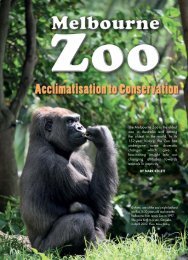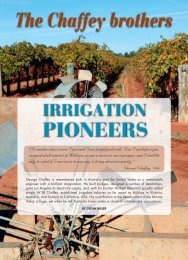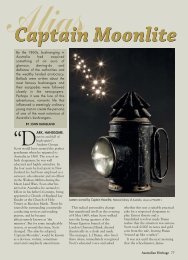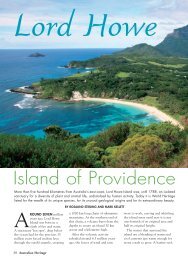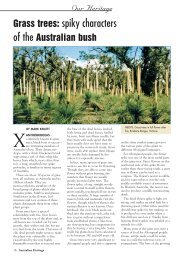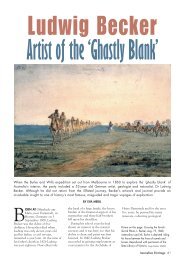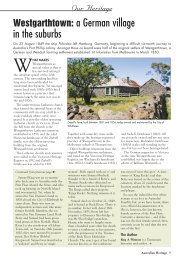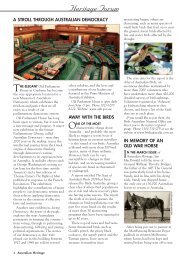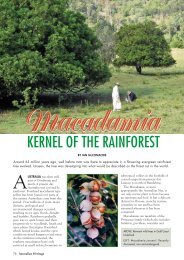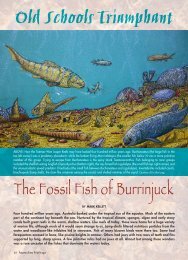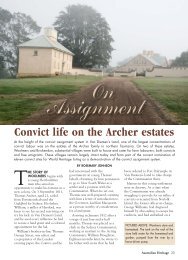Heritage 0609_OH Poltalloch.pdf - Australian Heritage Magazine
Heritage 0609_OH Poltalloch.pdf - Australian Heritage Magazine
Heritage 0609_OH Poltalloch.pdf - Australian Heritage Magazine
You also want an ePaper? Increase the reach of your titles
YUMPU automatically turns print PDFs into web optimized ePapers that Google loves.
Our <strong>Heritage</strong><br />
The Royal party at <strong>Poltalloch</strong> in November 1867.<br />
Davenport and McDougall bought<br />
100 head of horned Durham cattle<br />
for 5 guineas a head. These were<br />
from the herd of Joseph Hawdon,<br />
the first overlander from Sydney to<br />
Melbourne and to Adelaide. Later,<br />
in March 1845, under instructions<br />
from Samuel Davenport, McDougall<br />
began an epic ride overland to Port<br />
Phillip to purchase a further<br />
500–600 cattle. He completed this<br />
remarkable feat, returning by<br />
September of the same year having<br />
lost only two animals on the<br />
journey.<br />
Neill Malcolm hoped to<br />
encourage the emigration of tenants<br />
who had been displaced by<br />
clearances on his highland estates to<br />
settle in South Australia. Nothing is<br />
recorded in the Davenport letters of<br />
the planned emigration but a letter<br />
written by McDougall and dated<br />
September 1845, states:<br />
There is not the least doubt that<br />
any person who comes to the<br />
Colony will derive many benefits<br />
from doing so, and if some of my<br />
countrymen would pluck up<br />
courage enough to come, I am<br />
satisfied that they would have no<br />
cause to repent.<br />
Another of McDougall’s letters<br />
published in The South <strong>Australian</strong><br />
News, April 1845, gives a glimpse of<br />
daily life at the homestead:<br />
I have now commenced to lay out a<br />
garden, where I hope to cultivate<br />
the vine, orange and almond trees<br />
with success, this climate is so well<br />
adapted for their growth.<br />
Of the Aboriginal population<br />
McDougall comments:<br />
The natives who are very numerous<br />
at present are very quiet. I generally<br />
Map of lakes showing Malcolm’s 39th Survey.<br />
employ one of them as a water<br />
carrier, for a week at a time, and<br />
give him an old shirt, or an old pair<br />
of trousers, with which he seems<br />
perfectly satisfied.<br />
By all accounts McDougall<br />
enjoyed a good life on <strong>Poltalloch</strong>.<br />
His daily fare included fish of many<br />
varieties supplied by the Aborigines,<br />
kangaroo tail soup and locally shot<br />
game. Milk and butter was supplied<br />
by the dairy.<br />
<strong>Poltalloch</strong> played host to some<br />
famous visitors. English writer and<br />
traveller Anthony Trollope dined<br />
there while on his travels around<br />
Australia in the 1860s. He wrote:<br />
I also visited a large cattle-station<br />
in the south of the colony, on the<br />
eastern side of the lakes. It belongs<br />
to a rich Scotch absentee<br />
landowner who sits in our<br />
parliament, and I will only say of it<br />
that I think I ate the best beef there<br />
that ever fell my way.<br />
Praise indeed! <strong>Poltalloch</strong> beef had<br />
already taken prizes at the Adelaide<br />
Show. In 1859 two bullocks, “fatted<br />
on the grass of the Murray” took out<br />
first and second prizes.<br />
In 1867 Prince Alfred, Duke of<br />
Edinburgh and Queen Victoria’s<br />
second son, visited <strong>Poltalloch</strong> while<br />
on a camping and hunting tour of<br />
the Lakes region. He had travelled<br />
20 <strong>Australian</strong> <strong>Heritage</strong>



